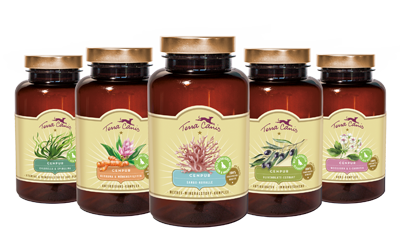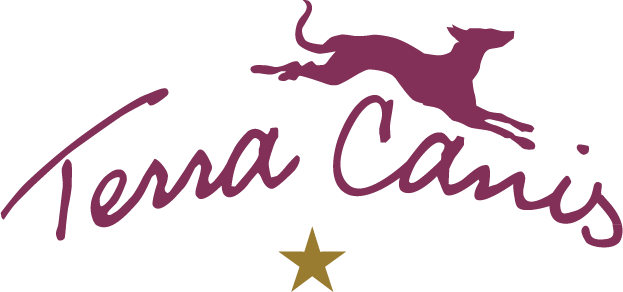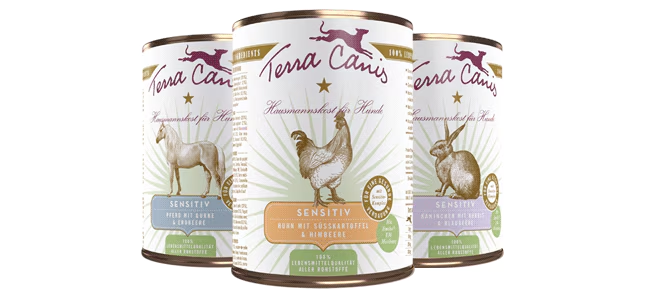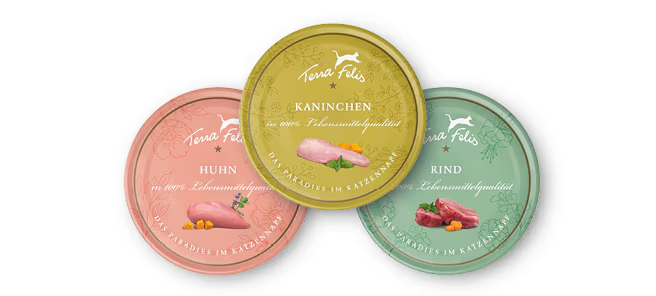Vitamins and minerals
Species-appropriate & natural pet food
For the past 15 years, Terra Canis has stood for completely species-appropriate, natural pet food – made from 100% human-grade quality ingredients for the first time In addition to the maximum quality of ingredients, Terra Canis has always considered a natural supply of vitamins, minerals and trace elements to be elementary for the dog.
As well as meat and over 40 different vegetable, fruit and herb varieties as sources of vitamins and similar, Terra Canis also uses numerous natural additives such as seaweed, mineral clay, eggshell, flower pollen, rose hip, brewer’s yeast, etc. to supply the dog with all essential micronutrients in a natural way. The organism of the dog/wolf has adapted over thousands of years to the natural intake of vitamins and minerals in the wild and can therefore distinguish between natural and artificial micronutrients, which has even been scientifically proven for some substances (e.g. Burton study on vitamin E). The so-called bioavailability of natural vitamins etc. is considered to be significantly higher than the bioavailability of synthetic vitamins and minerals. A dog therefore needs a lower intake of a natural vitamin in its diet to cover its requirements than it does of an artificial vitamin, since the natural vitamin arrives at its effective site in a much higher dose. A simple example: if, for example, an organism is supplied with 1000 mg of vitamin C in a natural and a synthetic form, the body absorbs a significantly higher amount of the more natural variant, while a higher proportion of the synthetic variant is excreted due to the poorer bioavailability. So in order for the same amount of vitamin C to arrive in the body, it is logical to assume that a higher amount of the synthetic variant must be supplied. Terra Canis menus have been developed in accordance with this perspective, which is backed up by multiple studies in the animal and human sector.
With regard to supplying the dog/cat with vitamins, minerals and trace elements, the authorities and legislation rely on the so-called NRC values, which specify the daily requirement values for convenience food for dogs and cats. These are listed in quantity/day/kg for each vitamin, bulk and trace element. These values originate from the National Research Council in the USA. The NRC values refer to the nutrient values of convenience foods, which are always supplemented with synthetic vitamin and mineral preparations, unlike Terra Canis, which is based on natural supplements. The NRC values therefore state the amounts of vitamins and minerals that must be contained in food products to meet the needs of dogs and cats, and are usually based on synthetic additives. As numerous studies have shown, this synthetic-based intake of vitamins and minerals leads to large amounts of them being excreted due to poor bioavailability. This means that in the case of synthetic substitution, higher amounts must be contained in the food than in the case of food with purely natural vitamins and minerals. Therefore products such as Terra Canis that contain purely natural micronutrients do not necessarily have to reach the NRC values because the natural substances can be absorbed and processed by the body to a greater extent. Unfortunately, authorities and legislation make no distinction between the natural and the synthetic supplementation of vitamins and minerals, despite the fact that there is an enormous difference, and demand compliance with the NRC values. Terra Canis nevertheless meets the NRC requirements for its menus solely through the fresh, human-grade quality meat, vegetables, fruit, herbs and also purely natural additives such as sea algae, eggshell, brewer's yeast, flower pollen etc. on average with 29 of the 35 essential vitamins, minerals and trace elements. However, we have to synthetically substitute a small amount, even if only with an average of 6 substances, at the request of the authorities. These are only very small amounts, which are completely harmless in these tiny dosages and only substitute the minimal difference compared to the NRC values, which in our opinion would not actually be necessary due to the high bioavailability of the natural vitamins and minerals contained in all our menus.
Further information about the topic of bioavailability:
What does bioavailability mean? Bioavailability is a measure used in pharmacology. It indicates the extent to which a certain (active) substance is absorbed by the organism and to what extent it is present at its specific site of action after being transported there. In the case of vitamins, it would be – using vitamin A as an example – the level of vitamin A dosage in the liver after consumption, digestion, transport via the blood to the presence of vitamin A in the liver.
If a substance has a very high bioavailability, it experiences very little loss during transport and can be used almost 100% by the organism for its intended purpose. With lower bioavailability, only a small amount of active ingredient reaches its desired ‘destination’, meaning that more has to be added to achieve the same effect. In the case of natural vitamins, this means that a smaller amount in the diet is sufficient to achieve the desired effects and nutritional goals, since their bioavailability is very high and the losses in their utilisation are therefore low. To achieve a comparable effect with synthetic vitamins, greater amounts need to be added.
Further information on the NRC values:
We can reassure all customers who are afraid that they have underfed or malnourished their dog over the last few years without these supplements being in the Terra Canis menus. The supplements are only added to comply with the authorities’ request to meet the NRC values. If you compare the NRC values for the dog with the values recommended for an adult, healthy human by the German Society for Nutrition (DGE), there is a surprising result:
almost all of the NRC values for dogs are higher, sometimes many times higher (always in reference to 1kg body mass) than for humans! However, there is no veterinary medical reason for this apparently clearly increased need of dogs compared to humans. The values for dogs in particular, which are 4-10 times the recommended daily amount for an adult, should cast some doubt on the meaning and purpose of these figures. In line with the motto ‘better too much than too little’, the industry justifies the level of these values as so-called safety margins.
Further information on natural versus synthetic vitamins:
When it comes to feeding dogs, the advantages and disadvantages of artificial versus natural additives come under frequent discussion. Moved to action by their own sick four-legged friend and as a result of a generally increased awareness of adopting a healthy lifestyle, more and more dog owners now pay attention not only to their own healthy nutrition, but also to that of their four-legged friend – and this frequently leads to putting natural ingredients back in the bowl. This “greater naturalness” should actually also mean “more natural vitamins” because the natural variant still seems to be far ahead of its synthetic twin, despite intensive research.
What science says
"The study on artificial vitamin E carried out by Graham Burton in Ottawa, which divided adults into 2 groups and supplied one group with purely artificial and the other group with purely natural vitamin E, is of interest in this respect. Following the experiment, the group that was exclusively supplied with artificial vitamin E had a significantly lower level of the vitamin than the “natural” group. (‘Biocenetics of Vitamin E using’, Graham Burton, Ottawa). This study is supported by the theories advanced by Hans-Ulrich Grimm in his published work ‘Vitaminschock’ (Vitamin Shock). Here, he explains in a comprehensive manner that a supply of purely artificial vitamins does not have the same effect on the metabolism as a supply of natural variants. The reason for this is the absence of the natural environment and thus the ‘team players’ of artificial vitamins through which the natural vitamins can unfold their full effect."
What the laws of nature say
Different precursors of vitamins, which are absorbed naturally by eating fruit or vegetables, enable certain interactions and various modes of action of the vitamins. Artificial vitamins are not capable of this because they lack cofactors – which is why they are clearly inferior to their natural twins. We still do not know how many types of vitamins are found in naturally grown foods such as fruit, vegetables, etc. It is therefore difficult to almost impossible to artificially reproduce all vitamins in their entirety. The health effect of an artificial vitamin can therefore never, based on what is currently scientifically possible, reach 100 % of that provided by complex and natural foods. Fruit and vegetables contain not only the individual vitamins, but also secondary plant substances such as polyphenols, which support and facilitate the effect of the vitamins, as nutrition researcher Günther Wolfram from the Technical University of Munich was able to show in his studies. An example of this is: Vitamin E in its natural form comprises 16 different variants, which make up vitamin E in their entirety. However, only one variant can be chemically reproduced! This is also the only variant that can be measured by chemical tests during investigations (Vitaminschock, Hans-Ulrich Grimm, Droemer-Knaur Verlag). To reproduce vitamins in the laboratory is a complex undertaking and, despite intensive research, does not come close to the construction of their natural variants because it is not just the correct “molecular formula” that is decisive in this respect, but also their structural arrangement in relation to one other. If just one atom is located elsewhere within the organic compound, the entire function of the vitamin can be different.
The best example of this is vitamin E, which can only be artificially produced as so-called “alpha-tocopherol”. However, the delta and gamma form of the vitamin, which still cannot be produced synthetically, are naturally occurring and preferred by the organism. The natural form of vitamin E not only has better bioavailability, but also increased antioxidative (cell-protecting) functions, which the artificial variant does not have. The artificial vitamin E is thus clearly inferior both in its utilisation and in its function. Even with artificially produced ß-carotene, the structural arrangement does not correspond to the natural model. This structural deviation prevents a transformation when it is transported in the blood. The extent to which the effect of ß-carotene is impaired by this is currently still the subject of research. However, these examples show how complex the reproduction of a vitamin is. In addition to the missing environment, it is also the vitamin itself which must be exactly reproduced down to the last atom in order to fully achieve the natural effect. Based on what is currently scientifically achievable, such a copy will never be possible.
Natural vitamins and minerals





